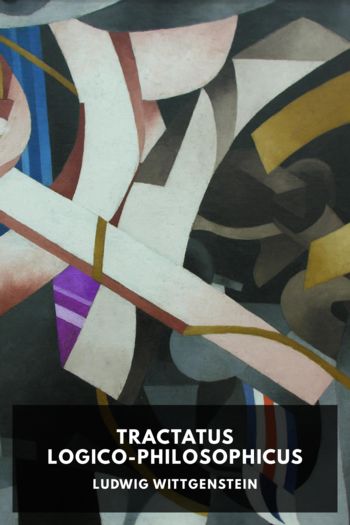Tractatus Logico-Philosophicus - Ludwig Wittgenstein (top 10 ebook reader TXT) 📗

- Author: Ludwig Wittgenstein
Book online «Tractatus Logico-Philosophicus - Ludwig Wittgenstein (top 10 ebook reader TXT) 📗». Author Ludwig Wittgenstein
It is form and content.
2.0251Space, time and colour (colouredness) are forms of objects.
2.026Only if there are objects can there be a fixed form of the world.
2.027The fixed, the existent and the object are one.
2.0271The object is the fixed, the existent; the configuration is the changing, the variable.
2.0272The configuration of the objects forms the atomic fact.
2.03In the atomic fact objects hang one in another, like the links of a chain.
2.031In the atomic fact the objects are combined in a definite way.
2.032The way in which objects hang together in the atomic fact is the structure of the atomic fact.
2.033The form is the possibility of the structure.
2.034The structure of the fact consists of the structures of the atomic facts.
2.04The totality of existent atomic facts is the world.
2.05The totality of existent atomic facts also determines which atomic facts do not exist.
2.06The existence and nonexistence of atomic facts is the reality.
2.061Atomic facts are independent of one another.
2.062From the existence or nonexistence of an atomic fact we cannot infer the existence or nonexistence of another.
2.063The total reality is the world.
2.1We make to ourselves pictures of facts.
2.11The picture presents the facts in logical space, the existence and nonexistence of atomic facts.
2.12The picture is a model of reality.
2.13To the objects correspond in the picture the elements of the picture.
2.131The elements of the picture stand, in the picture, for the objects.
2.14The picture consists in the fact that its elements are combined with one another in a definite way.
2.141The picture is a fact.
2.15That the elements of the picture are combined with one another in a definite way, represents that the things are so combined with one another.
This connection of the elements of the picture is called its structure, and the possibility of this structure is called the form of representation of the picture.
2.151The form of representation is the possibility that the things are combined with one another as are the elements of the picture.
2.1511Thus the picture is linked with reality; it reaches up to it.
2.1512It is like a scale applied to reality.
2.15121Only the outermost points of the dividing lines touch the object to be measured.
2.1513According to this view the representing relation which makes it a picture, also belongs to the picture.
2.1514The representing relation consists of the coordinations of the elements of the picture and the things.
2.1515These coordinations are as it were the feelers of its elements with which the picture touches reality.
2.16In order to be a picture a fact must have something in common with what it pictures.
2.161In the picture and the pictured there must be something identical in order that the one can be a picture of the other at all.
2.17What the picture must have in common with reality in order to be able to represent it after its manner—rightly or falsely—is its form of representation.
2.171The picture can represent every reality whose form it has.
The spatial picture, everything spatial, the coloured, everything coloured, etc.
2.172The picture, however, cannot represent its form of representation; it shows it forth.
2.173The picture represents its object from without (its standpoint is its form of representation), therefore the picture represents its object rightly or falsely.
2.174But the picture cannot place itself outside of its form of representation.
2.18What every picture, of whatever form, must have in common with reality in order to be able to represent it at all—rightly or falsely—is the logical form, that is, the form of reality.
2.181If the form of representation is the logical form, then the picture is called a logical picture.
2.182Every picture is also a logical picture. (On the other hand, for example, not every picture is spatial.)
2.19The logical picture can depict the world.
2.2The picture has the logical form of representation in common with what it pictures.
2.201The picture depicts reality by representing a possibility of the existence and nonexistence of atomic facts.
2.202The picture represents a possible state of affairs in logical space.
2.203The picture contains the possibility of the state of affairs which it represents.
2.21The picture agrees with reality or not; it is right or wrong, true or false.
2.22The picture represents what it represents, independently of its truth or falsehood, through the form of representation.
2.221What the picture represents is its sense.
2.222In the agreement or disagreement of its sense with reality, its truth or falsity consists.
2.223In order to discover whether the picture is true or false we must compare it with reality.
2.224It cannot be discovered from the picture alone whether it is true or false.
2.225There is no picture which is a priori true.
3The logical picture of the facts is the thought.
3.001“An atomic fact is thinkable”—means: we can imagine it.
3.01The totality of true thoughts is a picture of the world.
3.02The thought contains the possibility of the state of affairs which it thinks. What is thinkable is also possible.
3.03We cannot think anything unlogical, for otherwise we should have to think unlogically.
3.031It used to be said that God could create everything, except what was contrary to the laws of logic. The truth is, we could not say of an “unlogical” world how it would look.
3.032To present in language anything which “contradicts logic” is as impossible as in geometry to present by its coordinates a figure which contradicts the laws of space; or to give the coordinates of a point which does not exist.
3.0321We could present spatially an atomic fact which contradicted the laws of physics, but not one which contradicted





Comments (0)